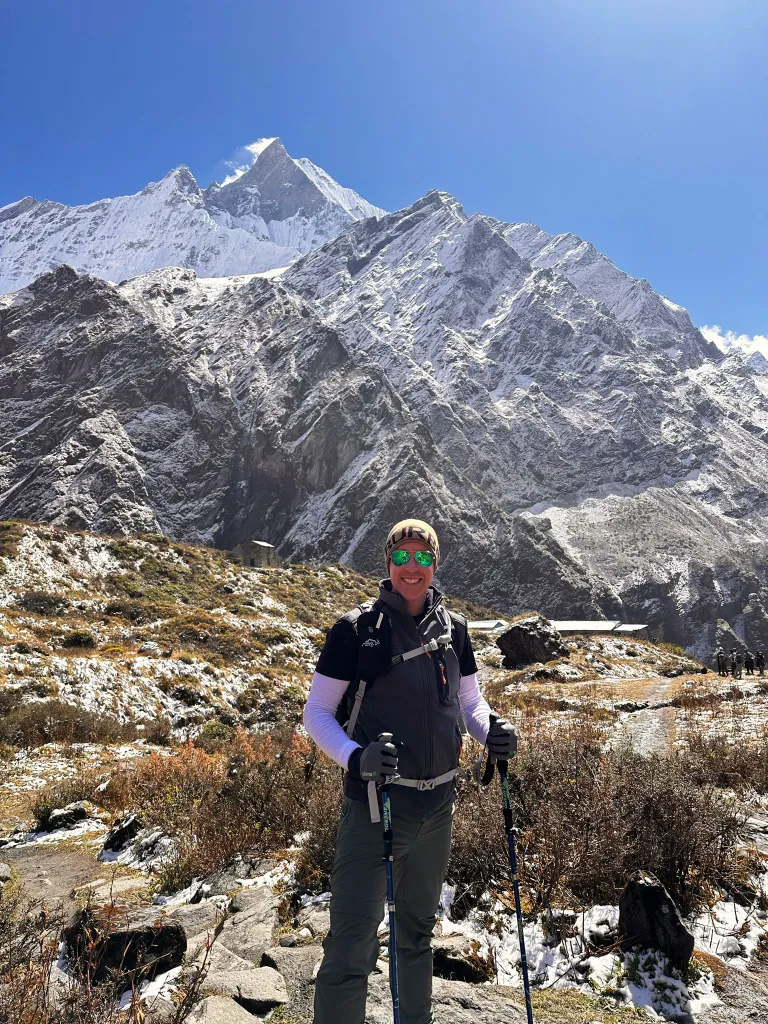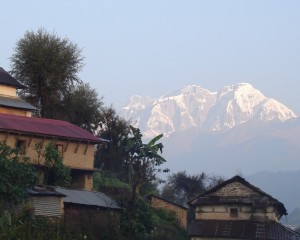Is Getting a Tattoo in Nepal Worth It?
I've always found the idea of marking an unforgettable adventure or a special moment with a tattoo captivating. It’s a piece of art that stays with you forever, reminding you of a place or experience that meant something. This thought hit me hard as I was wrapping up my Everest Base Camp trek in the spring of 2023. As I wandered through the busy streets of Thamel, I had the sudden urge to get inked, something that would symbolize my incredible journey in Nepal.
I had previously gotten a tattoo in memory of my late dogs, a tribute to our deep bond. But this time, I wanted something that captured a different kind of connection — one with the towering peaks of the Himalayas, the calm they exude, and the strength of the Sherpas who live and thrive at such high altitudes. To honor this experience, I decided to explore the tattoo shops in Nepal, looking for a design that perfectly captures this journey.
Along the way, I discovered a lot—from ancient designs to modern tattoo studios in Kathmandu. Now comes my personal experience of getting inked in Nepal and everything I learned along the way.
Tattoo Culture in Nepal
I always thought tattoos were just a modern trend, but when I came to Nepal, I was amazed to learn how deep the tattoo culture runs here. The more I explored, the more I realized that tattooing has been part of local traditions for centuries. I was excited to discover that Nepal's tattoo scene blends old traditions with modern styles, and getting a tattoo here was an unforgettable experience.
Historical and Tribal Roots
When I started learning about Nepal's tattoo history, I learned that tattoos have been part of local culture for a long time. One of the most fascinating traditions comes from the Tharu people living in the southern plains. Tharu women have been tattooed with designs called khodna or godna for centuries. These tattoos represent beauty, identity, and spiritual beliefs. I learned that tattoos usually show natural things like flowers, birds, the sun, ponds, and even some mythical stories. Interestingly, the tattoos were also believed to protect women from danger.

Then, I discovered the Newar community’s tattooing tradition in the Kathmandu Valley. Newar women wear tattoos called lha-chyogu, which means "writing on flesh." These tattoos symbolize strength, beauty, and social status, and I could see how much they meant to the people who wore them. It made me realize that tattoos in Nepal have a lot of meaning, not just for style but also for culture and history.
Modern Evolution
Now, tattoos are not just part of history; they’re very much alive in modern Nepal. In places like Kathmandu, Pokhara, and Thamel, tattoo studios have popped up that highlight both traditional and contemporary designs. I went to a tattoo studio in Thamel and was surprised to see how popular tattoos are with young Nepalis. For them, tattoos have become a way to express themselves and tell their stories.
Blending Traditional and Contemporary Styles
What I loved most about getting a tattoo in Nepal was how the traditional and modern styles blended beautifully. I chose a design that featured a peak wrapped by a chorten, symbolizing my deep connection to the mountains and the spiritual journey I experienced during my Everest Base Camp trek.
I shared my idea with my guide and friend, Deepak, and the tattoo designer, and both liked it.
The tattoo artist used fine lines and intricate details to give it a fresh, modern look while still honoring Nepal's traditional spiritual elements. It felt like the perfect way to remember my trek, respect Nepal's deep-rooted culture, and carry a piece of it with me forever.
Tattoo Cost Breakdown in Nepal
During my research, I found that tattoo prices in Nepal vary depending on factors like size, design complexity, and the artist’s experience. For small tattoos, prices typically range from NPR 1,500 to NPR 7,000, while larger, more detailed tattoos can cost between NPR 10,000 and NPR 50,000 or more. Interestingly, there isn't usually a significant price difference between locals and tourists, though some studios may offer discounts for repeat customers. Most studios provide free consultations to discuss design ideas; some even include a free touch-up session within a certain period.
Aftercare instructions are also commonly offered to help ensure proper healing. While tipping is not mandatory, it's appreciated, with 10-20% considered generous. My tattoo cost Rs 2000 with a 5% tip, as it was a small design.

Tattoo Aftercare Tips
- Wash gently with mild, fragrance-free soap and lukewarm water.
- Apply a thin layer of fragrance-free lotion or healing ointment to hydrate the tattoo.
- Keep your tattoo out of direct sunlight to prevent fading and irritation.
- Avoid swimming or soaking in water for 2-3 weeks during healing.
- Look for signs of infection, such as redness, swelling, or pus, and seek medical attention if needed.
How to Find a Suitable Tattoo Artist
- Research Studios: Look up tattoo studios with good reviews and ratings.
- Check Artist Portfolios: See the artist's past work to ensure their style matches what you want.
- Ask for Recommendations: Get suggestions from locals or other travelers for trusted artists.
- Visit Studios: Check out the studio in person to ensure it’s clean and professional.
- Discuss Your Design: Talk to the artist about your tattoo idea to ensure they understand your vision.
Does it hurt?
Yes and no. Getting a tattoo can be painful, depending on the location on your body, your pain tolerance, and the size or complexity of the design.
It was just a tiny sting for me since I opted for a small design on my hand. The sensation was bearable and lasted only a few minutes, making it a relatively easy experience. However, areas with less flesh or more nerve endings, like ribs or elbows, can be more painful. The level of discomfort can also vary depending on the artist's technique and the tattoo's size and detail. But overall, the pain is temporary, and the excitement of getting a meaningful tattoo often outweighs it.
My Tattoo Experience
I got my tattoo at Sarashi Tattoo Studio in Kathmandu, and it was such a great experience. The studio is known for its talented artists and welcoming atmosphere. It’s women-owned and LGBTQ+ friendly, with modern amenities like gender-neutral restrooms and NFC mobile payments, which made me feel comfortable and at ease from the moment I stepped in.

The vibe in the studio was excellent. The staff was super friendly, and the artists were skilled, making the experience relaxed and creative. It felt like a safe and professional place to get inked.
For my design, I chose a small tattoo of a peak wrapped by a chorten, symbolizing my connection to the mountains and my spiritual journey during my Everest Base Camp trek. The tattoo artist used fine lines and small details to give it a fresh, modern look while still honoring the traditional spiritual elements of Nepal. It was the perfect way to carry a piece of my journey with me and reflect on the knowledge I gained from the Himalayas.
Since I chose a small tattoo, the pain wasn’t bad at all – just a little sting. The process took less than half an hour, and I was pleased with the result. Every time I look at it, I reflect on my trek and the lessons I learned along the way.
Other Amazing Tattoo Studios in Nepal
In my research, I found these fantastic tattoo studios, too:
- Aamali Tattoo Inn (Kathmandu) – 4.9/5
- tik’e jhya TATTOO (Kathmandu) – 4.7/5
- Tranquil Tattoo (Pokhara) – 4.9/5
- Mohan's Tattoo Inn (Kathmandu, India, New York) – 4.6/5
- Gagan Tattoo Inn (Kathmandu, Pokhara) – 4.7/5
How Nepal Vision Treks Inspired My Tattoo Journey
After completing my trek, I was so moved by my experience in Nepal that I decided to get a tattoo as a tribute to the journey. My guide from Nepal Vision Treks, Deepak, played a key role in helping me find the perfect design that captured the essence of my adventure. Many trekkers, like me, have been inspired by their time in Nepal to get tattoos that symbolize their experiences—some go for mountain landscapes, others choose meaningful symbols like prayer flags or mandalas. The connection between the trek and these permanent reminders in ink is something truly special.
Is It Worth Getting a Tattoo in Nepal?
For me, the answer is a definite yes. Nepal offers talented artists, reasonable prices, and a deep-rooted tattoo culture. Whether you're seeking a memento of your travels or a design with personal meaning, getting a tattoo in Nepal adds something unforgettable to your journey. If you're considering making your Nepal trip even more memorable, check out Nepal Vision Treks and tag us in your tattoo story on Instagram @nepalvisiontreks. You might even win a free one-hour tattoo session at a top-rated studio!

As we come to an end, my experience of getting a tattoo in Nepal was truly incredible. Everything went so quickly from the professional artists who kept me comfortable to the smooth process of getting inked. The artist's skill was impressive, and the entire experience was quick and seamless.
Now, every time I look at the small peak on my hand, I can't help but smile as memories of my fantastic journey flood my mind. It's the perfect way to carry a piece of Nepal with me forever.
FAQS






